
Pipits and Waxwings
Oregon has one pipit and two species of waxwings.

Types of Pipits and Waxwings

Shadow-colored skulkers in dense riparian growth, catbirds are among the often heard, less frequently seen denizens of northeast Oregon. They are all dark gray except for a black cap and russet undertail coverts. The sound has variable melodious warblings with occasional imitations of other birds and off-key noises. A distinct mewing call is often heard.
The Gray catbird is a fairly common breeder in dense riparian zones of the northeast Blue Mountain ecoregion and is common in the Wallowa and Union counties and in east Umatilla County along the Umatilla River, Pine Creek and Meacham Creek. They breed locally in Baker County along the Powder River, Pine Creek, and Burnt River.
Hear the song of the Gray catbird
Hear the call of the Gray catbird
Photo by Tim Stockton, Flickr

World famous for its loud, persistent singing and mimic abilities, the Mockingbird is highly conspicuous. The white flashes in the wings and tail of this grayish bird identify it in flight.
It is primarily a southern species that has, by taking advantage of the environmental changes brought about by the ever-increasing human population, expanded its range northward in recent years. In many parts of the country it is a familiar bird of residential neighborhoods.
Hear the call of the Northern mockingbird
Photo by ©Keith Kohl, ODFW

More often heard than seen, this eloquent singer is the quintessence of the sage-dominated Great Basin. Its pale eye, short bill, brownish-gray back, boldly streaked breast, and long, white-cornered tail distinguish this towhee-sized thrasher.
It is often glimpsed darting or running low across the road, tail corners flashing, then disappearing abruptly into the brush. Its aerobatic display flight and tireless vocalizations are its most outstanding features.
Hear the song of the Sage thrasher
Photo by Tom Benson, Flickr

The European starling is considered an invasive species in Oregon. It was introduced from Europe.
They most closely resemble blackbirds, with which they often flock in fall and winter. While both have iridescent plumage, starlings can be told from blackbirds by their two-toned wing pattern - dark upperwing, pale underwing - and during the breeding season by the bright yellow bill.
Starlings adapt readily and quickly to human habitation and are highly efficient and successful breeders. However, the abundance of the bird, the rapidity with which it has spread across North America, and its propensity to cause damage to crops and native bird populations cause the starling to be disfavored by many and remind us of how much damage an introduced species can cause.
They are a common to abundant breeder in urban areas, and locally common in agricultural areas throughout the state where buildings and trees are present.
Hear the call and song of the European starling
Photo by Kathy Munsel, ODFW

These small, buff ground-dwellers are often seen in migration as they pass overhead in lisping flocks or as they walk deliberately along a muddy shore, tilled field, or short-grass upland with their tails slowly bobbing.
Breeding birds are grayish above and lightly streaked below; winter birds are more heavily streaked below and brownish above. All plumages have cream-buff undersides (brightness varies) and a dark tail with white outer feathers.
The American pipit is locally common in lowlands in winter, especially in western Oregon and on the coast. Hundreds of pipits can be found some years in preferred habitat in the central Willamette Valley and coastal pastures.
Hear the call of the American pipit
Photo by Mick Thompson, Flickr

The Bohemian waxwing is a nomadic species, invading locations with fruit-bearing trees or shrubs. Referred to as a "roving bands," their name reflects this view of their unpredictable and seemingly carefree lifestyle.
Very sociable birds, they exhibit pronounced flocking habits in the winter, and frequently give themselves away with their constant gentle seeping or trilling voice. Their sleek profile and elegant, almost exotic coloration also distinguish these birds.
Hear the song of the Bohemian waxwing
Photo by Kathy Munsel, ODFW

One of Oregon's most efficient fruit-eaters and a perennial irritant to cherry, blueberry, and grape growers, the Cedar waxwing is a sleek, social resident of mixed forests and urban areas throughout the state.
Smooth, tan-brown plumage, a black mask with a mall head crest, red waxy wingtips, and a yellow tipped tail give Cedar waxwings a distinctive appearance.
The breeding range of the Cedar waxwing covers most of Oregon, except for the extensive conifer forests and expansive treeless areas with greater breeding populations reported in lowlands.
Hear the call of the Cedar waxwing
Photo by Kathy Munsel, ODFW

